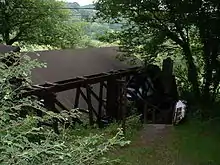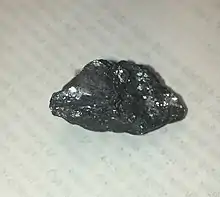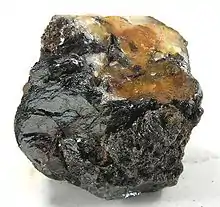Kelly Mine, Devon
Kelly Mine is a disused metalliferous mine situated on the eastern flank of Dartmoor near the village of Lustleigh in Devon, England. It was intermittently operational from the 1790s until 1951. It is one of some ten mines and two or three trials within the triangle formed by the towns of Bovey Tracey and Moretonhampstead and the village of Hennock, which worked deposits of micaceous haematite, known as "shiny ore". Since 1984 the mine has been the subject of a volunteer restoration project.


Activity
A mining lease dated to the 1790s forms the first record of mining on this site, and some work may have continued until the early 1870s. The mine reopened in 1879 and from then until 1891 it produced 324 tons of haematite—a relatively small amount. From 1892 the mine was closed until 1900 when it restarted under the Scottish Silvoid Company who ran it until 1917 when it was taken over by Ferrubron, who were also running the nearby Great Rock Mine. Ferrubron ran the mine until mining ceased on the site in 1946.[1] For a year or two from 1950 the company working Pepperdon Mine opened a level to extract ore near to Kelly Mine, and the washing plant at Kelly was used for the initial treatment of this ore.[2]
The mine never employed a large number of people; in the fifty years to 1938 it had an average of six workers, and rarely more than ten.[1]
Preservation and restoration
Kelly Mine, although a relatively small mine, is of significance today as an industrial heritage site. When the mine finally closed in 1951, the company then running the operation was in debt to the land owner for rent and for royalties on the ore extracted. In lieu of payment the company left the machinery on the site, where it remained substantially untouched for over thirty years.[3]
In 1984 the owner agreed to lease the site to a group of mining enthusiasts, now known as the Kelly Mine Preservation Society (KMPS).[4] The society is restoring and preserving the mine for future generations and has refurbished the mine and restored the machinery and processing plant to working order.

Micaceous haematite
Micaceous haematite, known as "shiny ore", is a flaky form of iron(III) oxide, Fe2O3. The ore has no value for the production of iron, but among other uses it was found to make very effective corrosion-resistant paint. Fuelled by the increased demand for protection of the new steel structures of the industrial age, some Devon micaceous haematite mines survived well into the twentieth century. The paint is still widely produced from ore mined in other countries.[5]
References
- Atkinson, Michael; Burt, Roger; Waite, Peter (1978). Dartmoor Mines: the mines of the granite mass. University of Exeter: Exeter Industrial Archaeology Group. pp. 35–38. ISBN 0-906231-00-0.
- Brooks, Tony (2004). Devon's Last 'Metal' Mine: Great Rock 'Shiny' Ore Mine. St Austell: Cornish Hillside Publications. pp. 156–7, 162. ISBN 1-900147-32-7.
- "Kelly Mine". Kelly Mine. Retrieved 6 July 2016.
- "Kelly Mine is time capsule". BBC - Devon - Local History. 5 March 2008. Retrieved 23 April 2011.
- "The History of Kelly Mine at Lustleigh". Widecombe History Group. Retrieved 6 July 2016.
External links
- Kelly Mine - Kelly Mine Preservation Society